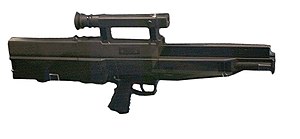Heckler & Koch G11
| Heckler & Koch G11 | |
|---|---|

The G11
|
|
| Type |
Assault rifle (G11) Light machine gun (LMG11) Personal defense weapon (G11 PDW) |
| Place of origin | West Germany |
| Production history | |
| Designer | Heckler & Koch |
| Designed | 1968–1990 |
| Variants | Assault Rifle Light Machine Gun (LMG11) Personal Defence Weapon (G11 PDW) |
| Specifications | |
| Weight | 3.6 kg (8.0 lb) empty, 4.3 kg (9.5 lb) loaded |
| Length | 750 mm (29.5 in) |
| Barrel length | 540 mm (155 mm per twist) |
|
|
|
| Cartridge |
|
| Action | Gas-operated, rotary breech (for G11 series) |
| Rate of fire |
|
| Muzzle velocity | Approx. 930 m/s (3,050 ft/s) |
| Effective firing range | 400 m |
| Feed system | 45- or 50-round detachable box magazine |
| Sights | Integrated optical sight |
| 4.73×33mm | ||||||||
|---|---|---|---|---|---|---|---|---|

The 4.73×33mm caseless ammunition used in the G11 rifle. The components are, from left to right, the solid propellant, the primer, the bullet, and a plastic cap that serves to keep the bullet centered in the propellant block.
|
||||||||
| Type | Rifle | |||||||
| Place of origin |
|
|||||||
| Production history | ||||||||
| Designer | Heckler & Koch | |||||||
| Specifications | ||||||||
| Case type | Caseless | |||||||
| Bullet diameter | 4.70 mm (0.185 in) | |||||||
| Base diameter | 7.76 mm (0.306 in) | |||||||
| Overall length | 32.83 mm (1.293 in) | |||||||
| Rifling twist | 155 mm (1 in 6.1 in) | |||||||
| Maximum pressure | 385.00 MPa (55,840 psi) | |||||||
| Ballistic performance | ||||||||
|
||||||||
| Test barrel length: 540 mm (21 in) | ||||||||
The Heckler & Koch G11 is a non-production prototype assault rifle developed during the late 1960s, 1970s and 1980s by Gesellschaft für Hülsenlose Gewehrsysteme (GSHG) (German for "Corporation for Caseless Rifle Systems"), a conglomeration of companies headed by firearm manufacturer Heckler & Koch (mechanical engineering and weapon design), Dynamit Nobel (propellant composition and projectile design), and Hensoldt Wetzlar (target identification and optic systems). The rifle is noted for its use of caseless ammunition.
It was primarily a project of West Germany, though it was also of significance to the other NATO countries as well. In particular, versions of the G11 were included in the U.S. Advanced Combat Rifle program.
In 1990, H&K finished the development of the G11, intended for the Bundeswehr and other NATO partners. Although the weapon was a technical success, it never entered full production due to the political changes of German reunification and lack of procurement contract. Only 1000 units were ever produced, some of which made their way into the hands of the Bundeswehr. Ultimately, the German armed forces replaced the G3 with the G36.
Development began around 1967 when NATO launched the idea of adopting a second standard small-caliber ammunition. Three competitors were then nominated : one American, another Belgian, and finally the German Heckler & Koch. NATO quickly lost interest in caseless ammunition but the West German Government held on. Within 1968–1969, the former West German Government started a feasibility study into a future assault rifle and three contracts were awarded respectively to Diehl, IWKA Mauser and Heckler & Koch (based in Oberndorf). The terms of reference (specifications) were very general, calling for an improved infantry weapon with a better hit probability (Ph) than any then in existence, yet fulfilling the FINABEL (named after France, Italy, Netherlands, Allemagne, Belgium and Luxembourg) range and rate of fire characteristics. The designers were given a free hand as to the methods used, but Heckler & Koch realized that the only way to obtain any significant improvement was to radically change the approach.
...
Wikipedia
